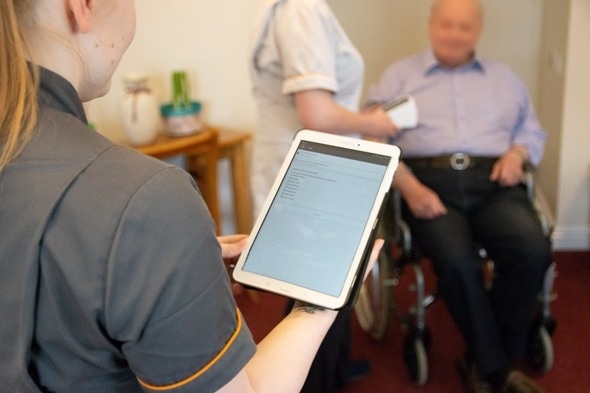Jun 29 2018
Care home workers are playing a vital role in an exciting new partnership between care homes and the NHS aiming to improve the quality of life of residents and reduce emergency hospital admissions in Sheffield.

The Digital Care Home is piloting a new model of collaborative working between health and care services in one of seven Test Beds funded by NHS England and the Department of Health.
Care home staff and NHS nurses are using technology in innovative ways to share information about residents as an ‘early warning system’ indicating early signs of an individual potentially becoming unwell.
The Digital Care Home approach enables carers to monitor a resident’s vital signs - respiration rate, oxygen saturation, temperature, blood pressure, heart rate and level of consciousness - and record this information digitally using a tablet app instead of using paper.
This information is then shared securely with nurses, in a central location at Sheffield Teaching Hospitals NHS Foundation Trust, for their assessment and support with clinical decision making; and to access expertise from GPs and nursing teams.
The nurses work in partnership with the care home teams to respond according to the needs of the individual and, where possible, prevent unnecessary admissions to hospital. Examples of responses include prioritized GP visits, increased resident monitoring, medication reviews, or community nurse home visits.
The service has been trialed in seven care homes in Sheffield with 70 residents taking part and, to date, over 35 care home workers have been trained to use the new technology.
Emma Smith is manager at Moorend Place, a 52-bed nursing home which specializes in dementia care in Sheffield. The facility is doubling the number of their residents taking part in the Digital Care Home project in the next phase of the trial.
Ms Smith said:
For our staff, the technology is very good, very quick and very easy to use. For our patients, the benefit is the potential to minimize admissions to hospital. A change in their environment can have a massive impact on their condition, so they need to be treated at their home.
The relationship with other care professionals is important. This project brings us all together. We are all singing from the same hymn sheet."
Amanda Fields is manager at Alexander Court, a 56-bed residential and nursing facility in Sheffield. The home is part of the HC One group, which sees potential to roll-out the service more widely.
Ms Fields said:
The technology has become part of our routine. If you can send a text message, you can use the app.
The service enables us to identify somebody who might be starting to become unwell earlier on rather than waiting for the usual symptoms to appear.
If we are identifying people earlier and can see their stats are out of range, it gives us time to speak to their GP who can start treatment for them. That’s welcome for the patient and the local health budget."
Philippa Hedley-Takhar, program manager for the Digital Care Home, said:
Our new collaboration between the care home community and local NHS services in Sheffield has been well received by those involved.
It represents a closer way of working between health and care services enabling important information about residents to be shared in order to tailor care to a resident’s specific needs.
As a result of the program, we are building strong new partnerships between care homes and healthcare professionals for the benefit of residents, their families and the wider health and social care system.
The care home teams taking part in the project have been wonderful. We couldn’t have done it without them."
Bryn Sage, chief executive of technology provider Inhealthcare, added:
The Digital Care Home project provides extra reassurance to residents and their loved ones that they are being looked after at their home, where they would much rather be than in A&E or a hospital ward.
This project is at the forefront of problem-solving innovation in the NHS and demonstrates the benefits of closer partnership working and collaboration between innovators, care homes and the NHS, and how health and care systems can make the best use of new technology.
We believe the Digital Care Home model is scalable and can be deployed rapidly across the country."
Seven care homes in Sheffield are currently participating in the Digital Care Home project – Balmoral; Moorend Place; Chapel Lodge; Haythorne Place; Chatsworth Grange; Alexander Court and Loxley Court Care Home.